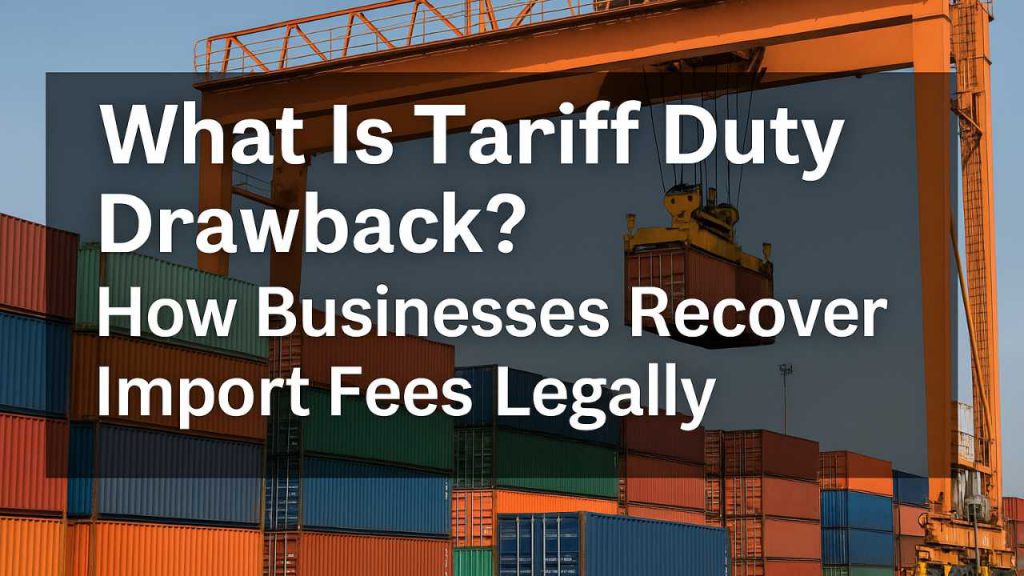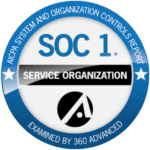Ever wished you could rewind a hefty bill and recover some of that hard-earned cash? Enter the world of tariff duty drawback, a financial rewind feature for businesses involved in international trade. Duty drawback allows companies to reclaim duties paid on imported goods that are later exported, an opportunity ripe with savings if managed properly.
For CFOs and logistics officers, understanding tariff duty drawback is akin to discovering a hidden vault of revenue. While the concept might sound like a convoluted tax dance, it essentially means you can claim refunds on import duties, taxes, and fees when eligible goods are exported or destroyed. A U.S. manufacturer, for example, could import components, assemble them into finished products, and then export them, legally claiming a portion of duties paid as cashback from Uncle Sam. And yes, it’s legal. Yes, it’s real. And yes, it requires paperwork—lots of it.
In this article, we’ll unravel the intricacies of tariff duty drawback—what it is, how it works, who qualifies, and how you can reclaim those elusive import fees with confidence. We’ll also highlight the potential pitfalls and offer insights into integrating these strategies with your transportation management system. So, sit tight as we navigate this fertile terrain and unlock your business’s potential for recovering import expenses legally. Ready to delve deeper?
What Is Tariff Duty Drawback? A Straightforward Definition
Tariff duty drawback is a mechanism allowing businesses to reclaim certain import duties, taxes, and fees previously paid on goods that are subsequently exported or destroyed. Yes, it’s legal. Yes, it’s real. And yes, it requires paperwork.
Why does this system exist? Simply put, it encourages domestic manufacturing and exports by reducing the cost burden on businesses engaged in international trade. It benefits import/export professionals, supply chain strategists, and financial teams looking to improve the bottom line.
The types of duty drawback typically fall into three categories:
| Types of Duty Drawback | Eligibility | Average Refund Timeline |
|---|---|---|
Unused Merchandise | Goods must stay unaltered before export | 3 to 12 months |
Rejected Merchandise | Must be defective, not conforming to specs, or shipped without the consignee’s consent | 3 to 12 months |
Manufacturing Drawback | Goods must be used in a manufacturing process and then exported | 3 to 12 months |
Remember, understanding and navigating this process effectively can save significant costs. For more comprehensive compliance and logistics support, consider partnering with experts like Hatfield & Associates to optimize your transportation management system.
Who Qualifies for Duty Drawback?
Duty drawback is a financial boon for industries involved in import/export, but just who qualifies? Primarily, businesses that import goods and later export them can benefit from this process. Imagine a U.S. manufacturer importing electronic components and exporting finished gadgets. Voilà, they qualify!
Eligible industries extend to those dealing with rejected goods, such as receiving faulty merchandise that must be returned, and manufacturers who use imported materials for goods intended for export. Yes, it’s legal. Yes, it’s real. And yes, it requires paperwork.
Common scenarios include:
- Export after import – Every time you ship those finished goods overseas, there’s potential for a refund.
- Rejected goods – Caught a lemon in your batch? No worries; send it back and claim the drawback.
- Manufacturing uses – Utilizing imported parts in production? Export the end product and recoup your import duties.
Whether you’re in electronics, textiles, or widgets—if you engage in these practices, duty drawback is your deserve-to-know secret. Dive into the process confidently with expert guidance from firms adept in navigating customs and logistics intricacies.
Types of Duty Drawback Programs
When diving into the world of import/export, understanding the types of duty drawback programs is crucial. These programs are designed to help businesses recover a portion of import duties paid on goods that are ultimately exported. Here’s a quick rundown:
- Unused Merchandise Drawback: This applies when imported goods are exported unused. Qualification requires proof of export and original import fee payments.
- Manufacturing Drawback: Aimed at manufacturers who import components, transform them, and export the finished product. To qualify, the manufacturing process must be documented to show compliance with specific regulations.
- Rejected Merchandise Drawback: Applicable for goods that are exported due to quality defects or shipment errors. Eligibility hinges on returning these goods unused.
Here’s a table outlining these types:
| Type | Eligibility Requirements | Average Refund Timeline |
|---|---|---|
Unused Merchandise | Documentation of import and export | 3-6 months |
Manufacturing | Proof of transformation process | 6-12 months |
Rejected Merchandise | Evidence of defect or error; unused on return | 3-6 months |
Each drawback type has unique qualifications but offers substantial financial returns, proving highly beneficial for businesses engaged in international trade.
How the Duty Drawback Process Works
Navigating the duty drawback process may seem as thrilling as watching paint dry, yet it’s a fiscal goldmine for businesses savvy enough to engage. Here’s how the process typically works:
- Documentation Gathering: To kick things off, businesses compile essential documents like proof of export, entry numbers, and import duties paid. Remember, U.S. Customs and Border Protection (CBP) lives for paperwork precision, so each T must be crossed, and each I dotted.
- Submission: Once your paperwork is as tidy as a Marie Kondo closet, it’s time to submit your claim. This step is where CBP comes into play, scrutinizing each entry for compliance.
- Review and Refund: Post-submission, CBP reviews the claim, a process that can demand the patience of a saint. On average, you might wait anywhere from a few months to over a year for your refund. But hey, good things come to those…
Including this process in your strategic operations is wise, and leveraging a transportation management system can streamline documentation and compliance efforts. For more nuanced guidance, consider exploring Hatfield & Associates’ expertise.
Benefits of Using a Duty Drawback Program
Unlocking financial benefits and enhancing margin recovery are significant advantages of utilizing a duty drawback program. A well-implemented program can transform your duty payments from a sunk cost into a competitive asset. Yes, it’s legal. Yes, it’s real. And yes, it requires paperwork, but the financial return is worth the administrative effort.
Real-World Example
Consider a U.S. manufacturer importing components and exporting finished goods. By leveraging a duty drawback program, they can reclaim thousands in import fees annually, boosting their bottom line significantly.
Key Benefits
- Financial Advantages and Margin Recovery: With duty drawbacks, businesses can recover up to 99% of duties paid on imported goods, turning costs into valuable working capital.
- Competitive Edge: In global markets, lower operational costs mean competitive pricing and improved market position.
Types of Duty Drawback Programs
- Unused Merchandise Drawback
- Rejected Merchandise Drawback
- Manufacturing Drawback
Whether you’re a seasoned CFO or a logistics rookie, fully understanding and utilizing duty drawback programs can provide considerable financial leverage. For a detailed overview of optimizing your transportation and compliance strategies, consider exploring the transportation management system offered by Hatfield & Associates.
Common Pitfalls and How to Avoid Them
When navigating the labyrinth of tariff duty drawback, seasoned import/export professionals know that even small missteps can lead to costly delays or outright denial of claims. Let’s address some common pitfalls and how to sidestep them smartly.
First, incomplete documentation can turn your dutiful dreams into a paperwork nightmare faster than you can say “CBP Form 7553.” Ensure all forms and records are detailed and accurate to avoid setbacks.
Second, misclassified goods are like misplaced socks—frustrating and avoidable. Incorrect classification under the Harmonized Tariff Schedule (HTS) can jeopardize your refund eligibility. Double-check HTS classifications for accuracy.
Third, failing to track refund eligibility over time might seem like less of an immediate concern. But procrastinating here is like leaving your passport at home before a trip—ultimately disastrous. Keep updated records and regularly assess eligibility to prevent missing out on potential refunds.
To mitigate these issues, consider implementing a robust transportation management system. Hatfield & Associates can help optimize your logistics approach and enhance your compliance strategy, ensuring your business not only meets but exceeds all regulatory requirements.
Integrating Duty Drawback into Your Transportation Management System
Integrating duty drawback into your transportation management system (TMS) can be as rewarding as it sounds. Consider it your logistics assistant—minus the need for caffeine.
A TMS can help streamline compliance and filings, automating routine tasks while ensuring accuracy and transparency. Imagine audit trails that resemble the breadcrumb paths left by Hansel and Gretel, sans getting lost in the regulatory forest. With automated reporting, your finance team can breathe easy, knowing they won’t face a paper avalanche each filing season.
How a TMS Streamlines Duty Drawback:
- Automation: Automatically capture and organize data.
- Audit Trails: Maintain detailed records for compliance checks.
- Real-Time Reporting: Generate instant insights to inform strategic decisions.
Feature | Benefit |
|---|---|
Automation | Reduces manual input and errors |
Audit Trails | Ensures accountability and transparency |
Reporting | Provides quick access to essential data |
By incorporating a TMS, businesses position themselves to navigate the complexities of international trade with confidence. For those in the import/export sector, a streamlined system isn’t just smart—it’s essential. Discover how transportation management system tools can enhance compliance and filings seamlessly.
Final Thoughts: Making Duty Drawback Work for Your Business
Navigating the world of tariff duty drawback can feel like unraveling a ball of yarn that insists on getting tangled. However, understanding and executing the process can lead to significant financial advantages for your business.
First, evaluate your eligibility by reviewing your import and export records. Consider the types of drawback you qualify for: unused, rejected, or manufacturing. Verify that all documentation aligns with U.S. Customs and Border Protection rules and the Tariff Act provisions.
Here’s a simplified list to guide you:
- Assess: Identify imported goods that qualify for drawbacks.
- Document: Ensure all necessary forms, like CBP Form 7553, are correctly filled.
- File: Submit claims within the statutory deadlines.
- Recover: Await refunds—patience required.
To simplify this process, consulting a logistics partner or compliance expert such as Hatfield & Associates can prove invaluable. They offer insights into optimizing duty drawback claims and enhancing your transportation management system (learn more here).
Remember, achieving perfection may involve some paperwork-induced headaches, but the financial returns are a testament that the effort is indeed worthwhile.
Frequently Asked Questions
Tariff duty drawback is a legal mechanism that allows businesses to reclaim import duties, taxes, and fees previously paid on goods that are subsequently exported or destroyed. This system encourages domestic manufacturing and exports by reducing cost burdens on international trade businesses. Companies can recover up to 99% of duties paid, essentially turning import costs into valuable working capital. The process involves submitting detailed documentation to U.S. Customs and Border Protection (CBP) and typically takes 3-12 months for refund processing.
Businesses engaged in import/export activities qualify for duty drawback programs, including manufacturers who import components and export finished goods, companies that receive rejected or defective merchandise that must be returned, and businesses that export imported goods in their original condition. Common scenarios include U.S. manufacturers importing electronic components and exporting finished products, companies dealing with faulty merchandise returns, and businesses using imported materials in production for export. Industries from electronics to textiles can benefit if they engage in these qualifying practices.
There are three main types of duty drawback programs: Unused Merchandise Drawback (for imported goods exported in their original, unused condition), Manufacturing Drawback (for businesses that import components, transform them through manufacturing, and export the finished products), and Rejected Merchandise Drawback (for goods exported due to quality defects, shipment errors, or non-conformance to specifications). Each type has specific eligibility requirements and refund timelines ranging from 3-12 months, with manufacturing drawback typically taking longer due to additional documentation requirements for the transformation process.
The duty drawback process involves three main steps: First, documentation gathering where businesses compile essential documents like proof of export, entry numbers, and import duties paid. Second, submission of claims to U.S. Customs and Border Protection (CBP) with all required forms including CBP Form 7553. Third, review and refund processing where CBP scrutinizes each claim for compliance, which can take anywhere from a few months to over a year. Precision in paperwork is critical as CBP requires exact documentation, and any errors can cause delays or claim denial.
Key benefits include significant financial advantages through margin recovery (up to 99% of duties paid can be reclaimed), competitive edge in global markets through lower operational costs and improved pricing, enhanced cash flow by converting sunk costs into working capital, and strategic advantages in international trade positioning. For example, a U.S. manufacturer importing components and exporting finished goods can reclaim thousands in import fees annually, substantially boosting their bottom line and market competitiveness while improving overall financial performance.
Common pitfalls include incomplete documentation (ensure all forms and records are detailed and accurate), misclassified goods under the Harmonized Tariff Schedule (double-check HTS classifications), and failing to track refund eligibility over time (maintain updated records and regularly assess eligibility). To avoid these issues, implement robust record-keeping systems, verify all documentation before submission, maintain accurate HTS classifications, and consider integrating duty drawback processes with transportation management systems for better tracking and compliance. Working with experienced logistics partners can also help navigate regulatory complexities effectively.




